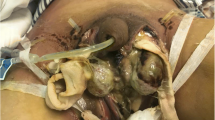Abstract
Ilioinguinal lymphadenectomy is associated with lymphorrhoea and skin necrosis. Lymphorrhoea may last for several days, and standard sterile dressing at home may not be feasible. A 36-year-old gentleman underwent bilateral ilioinguinal lymphadenectomy for urethral carcinoma and developed postop skin necrosis with excessive lymphorrhoea. After the wound was devoid of necrotic material, he was started on dressing with sanitary pads for absorbing the lymph and provide cover. He was managed at home with similar dressings, and wound healed well in 6 weeks. The sanitary pads provide cost-effective, easily available, absorbent, easy to use dressings for managing wounds with copious discharge.




Similar content being viewed by others
References
Stuiver MM, Djajadiningrat RS, Graafland NM, Vincent AD, Lucas C, Horenblas S (2013) Early wound complications after inguinal lymphadenectomy in penile cancer: a historical cohort study and risk-factor analysis. Eur Urol 64(3):486–492
Alqahtani M, Lalonde DH (2006) Sterile versus nonsterile clean dressings. Can J Plast Surg 14(1):25–27
Gilly FN, François Y, Sayag-Beaujard AC, Glehen O, Brachet A, Vignal J (1998) Prevention of lymphorrhea by means of fibrin glue after axillary lymphadenectomy in breast cancer: prospective randomized trial. Eur Surg Res 30(6):439–443
Carcoforo P, Soliani G, Maestroni U, Donini A, Inderbitzin D, Hui TT, Lefor A, Avital I, Navarra G (2003) Octreotide in the treatment of lymphorrhea after axillary node dissection: a prospective randomized controlled trial. J Am Coll Surg 196(3):365–369
Sweeney IR, Miraftab M, Collyer G (2012) A critical review of modern and emerging absorbent dressings used to treat exuding wounds. Int Wound J 9(6):601–612
Srivastava A, Prabhu S, Chumber S, Misra MC, Mehta SN, Guleria S, Kumar A, Bal S, Seenu V, Parshad R, Pandav CS, Saxena M (2001) Cost effectiveness of domiciliary vs. hospital based management of chronic wounds-a randomized trial. Ann Natl Acad Med Sci 37(3):107–113
Author information
Authors and Affiliations
Corresponding author
Ethics declarations
Conflict of interest
The author declares no competing interests.
Additional information
Publisher’s Note
Springer Nature remains neutral with regard to jurisdictional claims in published maps and institutional affiliations.
Rights and permissions
About this article
Cite this article
Murugesan, A. Cost-effective, Clean, Absorbent Dressings for Wounds with Copious Lymphorrhoea. Indian J Surg 83 (Suppl 4), 941–943 (2021). https://doi.org/10.1007/s12262-021-02843-w
Received:
Accepted:
Published:
Issue Date:
DOI: https://doi.org/10.1007/s12262-021-02843-w




